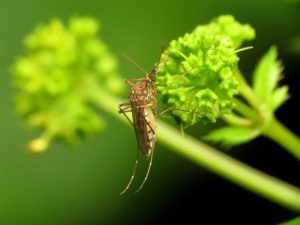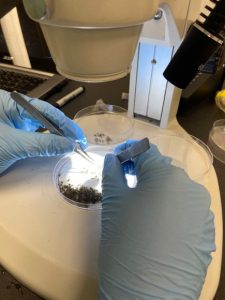Honey Bee Virus Found in Mosquitoes

While analyzing genetic signatures of microbes found in mosquitoes, researchers in Canada were surprised to find black queen cell virus, a common scourge of honey bees. The Aedes vexans mosquitoes in which the virus was identified likely acquired it while foraging for nectar at the same plants as bees, but it’s unclear if mosquitoes have any role in spreading it among bees. (Photo by Katja Schulz via Flickr, CC BY 2.0)
By Andrew Porterfield
Black queen cell virus is a serious problem for beekeepers. It infects developing queen honey bee larvae, turning other pupal cells black and ultimately killing the larval queen. The virus is capable of wiping out entire honey bee colonies and has no known deterrent beyond preventing its spread.
In 2020, when Canadian researchers were looking for viruses and other microbes spread by mosquitoes, a virus known for afflicting honey bees (Apis mellifera) was the last thing they expected to find. But they did.
As the researchers report in April in the Journal of Insect Science, for the first time, black queen cell virus (BQCV) has been discovered in North American mosquitoes. Also for the first time, researchers sequenced the virus’ genome.
Cole Baril, Christophe LeMoine, Ph.D., and Bryan Cassone, Ph.D., researchers at Brandon University in Manitoba, Canada, used a genetic sequencing method known as massively parallel next-generation sequencing to identify BQCV in a mosquito (Aedes vexans). The researchers believe that the mosquitoes indirectly acquired the virus by foraging at the same nectar sources as honey bees.
Since its discovery in 1955, BQCV has been known as one of the most common honey bee viruses. It is also one of the most poorly understood viruses affecting bees. Black queen cell virus infects queens and adult bees alike, but adults rarely show any symptoms of infections. It is part of the picornavirus order, and its genome consists of about 8,550 nucleotides of RNA. Exactly how it is transmitted from host to host is not fully understood. It may be spread by the microsporidia Nosema apis or by the Varroa mite, but it also may be transmitted by foraging expeditions of adult honey bees.
The scientists had been carrying out a genomics analysis of various mosquitoes in the Canadian prairie provinces. They identified several novel viruses and other microbial flora and were surprised to find BQCV during that search.

The Brandon researchers collected mosquitoes during 2019 and 2020 with miniature light traps. Aedes vexans mosquitoes were identified, and their RNA isolated. In 2019, 1,783 pooled mosquitos were sequenced; 2,208 were sequenced in 2020. The sequencing data was matched against BQCV sequences using the National Center for Biotech Information (NCBI) database.
The researchers also wanted to determine the evolutionary relationships within BQCVs and compared the new Canadian strain they’d found against existing viral genomes in the NCBI database. One of the sequencing reads matched a BQCV isolate from Sweden. No matches to Varroa mites or Nosema apis genomes were found, largely ruling out the potential for transmission through those organisms. However, three sequences were matched to plant chloroplasts and mapped to plants, trees and shrubs, indicating a foraging route of viral transmission.
Although mosquitoes need to feed on blood to produce eggs, flower nectar is also an important source of nutrition. Sugar deprivation is linked to reduced survival and reproduction capacity in females. However, no evidence exists showing that BQCV can replicate in mosquitoes, indicating that mosquitoes are a dead end for the viruses. But further research will be needed to determine if mosquitoes can transmit the virus to honey bees.
“To our knowledge, this is the first report of BQCV detected in mosquitoes or any other dipteran,” the authors write. “Interspecies transmission of BQCV has been hypothesized to be due to direct (parasitism, predation, and scavenging) and/or indirect (foraging at the same nectar source) interactions between honey bees and these arthropods.”
Cassone says much remains unknown. “The virus has been found in North America; however, never in mosquitoes and never has the genome sequence been characterized,” he says. “It is surprising to me that little work has been done with this virus given its potential determinantal impacts to apiculture.”
The study is also one of the first to use recently developed next-generation sequencing (NGS) techniques to characterize the insect and virus genome. The researchers recommended the further use of NGS but with a caveat common to sequencing: “Although it requires considerable integration of bioinformatics, many limitations of traditional approaches for pathogen identification (PCR methods and serological testing) can be overcome using NGS. In addition to its greater resolution and sensitivity, NGS does not require a priori knowledge of the nucleic acid to be sequenced or specific antibodies.”
We are here to share current happenings in the bee industry. Bee Culture gathers and shares articles published by outside sources. For more information about this specific article, please visit the original publish source: Honey Bee Virus Found in Mosquitoes (entomologytoday.org)








